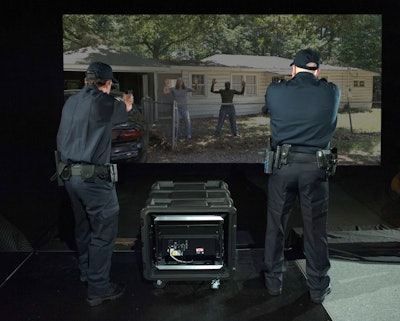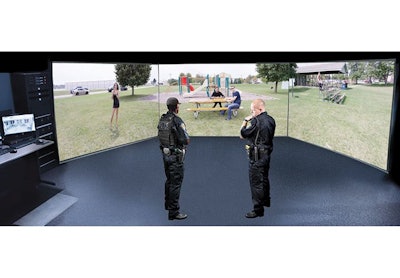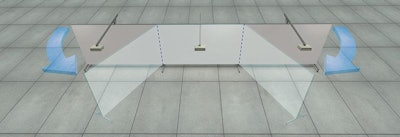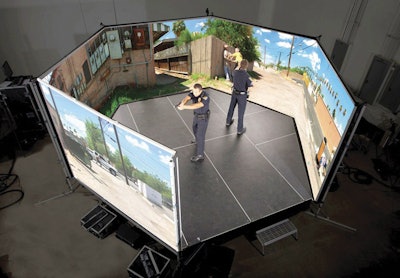 Photo: Meggitt Training Systems
Photo: Meggitt Training Systems
Technological advancements continue to enhance the training simulators used to prepare law enforcement officers for response to all types of calls. The current offerings in use-of-force simulator training provide customization so officers can experience scenarios as close to real life as possible. This includes a wide array of weapons, environmental factors, and even familiar locations that can be added to scenarios to recreate what officers encounter on a daily basis at an individual agency. Streamlined hardware and software and a wider range of options at the higher and lower ends of the cost spectrum make it easier for departments to find the right training solutions to meet their needs.
Adding to the variety of systems to choose from, Meggitt Training Systems has come out with the high-end FATS 100LE system and, at the opposite side of the spectrum, the entry-level FATS L7 LITE.
Meggitt Training Systems has modified the FATS 100e system it developed for a military contract to make it directly applicable to law enforcement agencies. The FATS 100LE combines both marksmanship and judgmental training in one package and features multiple screen capability, enhanced visuals, multiple weapons per trainee, and wireless BlueFire weapons. The system has been validated for both ballistics and accuracy.
Some of the features added for law enforcement include less-lethal weapons such as chem spray and TASERs in the judgmental application and something called soundboard, which allows the instructor to add sounds that aren't part of a scenario via directional speakers.
Other features allow for a more customized experience. Auto-coaching uses information provided by the BlueFire wireless weapon simulators used in a scenario to flag areas for improvement and suggests videos to use for the student's remedial training. Now an agency can also display its use-of-force policy or specialized training materials on the screen before a scenario. And to maximize usage, up to three FATS 100LE systems can be linked together for up to 15 students at one time, a feature that has only been available in Meggitt's military products before.
A new optional flashlight upgrade package for the FATS 100LE provides flashlight functionality in both the judgment and marksmanship training modes using commercially available flashlights, without modification. This can be used in the marksmanship mode with no effect to accuracy or hit detection, according to the company.
Meggitt's FATS L7 Lite is a pared-down version of the established FATS L7, with the option of later adding BlueFire weapons and accessories. It's designed for departments on a lower budget and comes with a laser insert so officers can start training immediately. The system has been modified to work with a CO2 kit for weapons. Recoil kits are optional.
www.meggitttrainingsystems.com
MILO Range offers a variety of training simulator systems, including its most advanced, called Theater. Not only does the MILO Range Theater system provide an immersive multiple screen experience, the images projected on those screens react to your movements. Advance, move left, move right, or move back, and your point-of-view changes on the screen accordingly. It is available in three- and five-screen versions, the Theater 180 and Theater 300. In addition to more scenarios that focus on conflict resolution and enable interaction with other first responders, MILO Range Theater now provides many new features to enhance realism, both visually and physically.
 Photo: MILO Range
Photo: MILO Range
New wireless biometric feedback tools worn on the wrist track a trainee's heart rate during scenario exercises to detect stress triggers. Because the devices are integrated with MILO Range software the results can be easily reviewed afterward. And with the MILO Range React feedback device, an instructor can wirelessly trigger trainee-worn devices to disrupt and distract them with lights, noises, and sensations during scenarios to increase focus. MILO Range Digital Integrated Scent Technology (MR-DIST) can be used to introduce scents at the right times, such as the smell of smoke in a scenario with a burning building in the background.
MILO Range Kinect HD for Theater includes Kinect for Windows hardware and custom MILO Range software add-ons to enable voice control of system and scenario branching and changes based on the officer's actions, as well as tracking for trainee point-of-view camera changes during training exercises in the simulator. The ability to work seamlessly with the FAAC driving simulator series further streamlines and enhances the simulator experience. In addition, new live-fire technology better allows agencies to use their laser simulator quickly and easily in a live-fire range using live ammunition, with portable, quick set-up options now available. And the MILO GreenFX application allows agencies to create their own scenarios using green screen technology.
The Training Lab is Ti Training's advanced simulator training system that accommodates up to 18 participants and comes with more than 800 scenarios, along with the ability to customize the scenarios or create and load your own. Recently, Ti Training has added to its offerings an expanded 180-degree Training Lab simulator system as well as a reconfigurable shoot house that can be taken down when not in use.
Ti Training's Training Lab EX, Expandable Range, uses three screens to create a 180-degree training environment that can be used flat or at any angle, because the projectors are connected to the screens and will move with them.
 Photo: Ti Training
Photo: Ti Training
You can line up the three screens and train with them flat, which is especially useful for multiple lanes during marksmanship training. Or in scenario mode you can push the wheel-mounted "wings" into place at any angle you want to train using special extra-wide scenarios that show on all three screens. Everything stays calibrated because it is all attached. For a standard-size scenario, just play it in the center screen. The system automatically switches between wide-screen and single-screen scenarios, even in the middle of a training session, because it's all on one system.
For a different training experience, Ti Training's Training Lab Ultra World shoot house is made of moveable, reconfigurable projector screen walls. The entire Training Lab Ultra World system can fit into a multi-purpose room.
You can project different scenarios onto the walls of the shoot house, and by utilizing four different projectors on the same computer system, walls in each section of the shoot house can play a different segment of the same scenario as the officer moves through it. For example, each section could be a different room in the same house. With the picture-in-a-picture camera, the instructor can see when a trainee enters a "room," to know how to direct the scenario in response to the trainee's actions.
Most of the scenarios designed for Training Lab Ultra World are "shoot/don't shoot," with lots of active shooter incidents. But the agency and the individual instructor can still choose how to let the events unfold.
VirTra offers a full line of judgmental use-of-force training simulators along with full weapons simulator training capability that allow officers to use verbal skills, less-lethal force options, and deadly force in a simulated environment. The company makes portable single-screen simulators on the lower end of the spectrum, but it's better known for its multi-screen solutions, the three-screen V-180 and five-screen V-300 simulator.
 Photo: VirTra
Photo: VirTra
The V-180 utilizes three screens for a 180-degree immersive training environment and can be used for both decision-making simulation and tactical firearms training. The system reconfigures to support nine lanes of individual firing lanes. The VirTra V-300 uses five screens to create a 300-degree immersive training environment. The system reconfigures to support 15 lanes of individual firing lanes.
Both systems allow you to debrief and record a trainee's performance, judgment, and reaction time. Other features include seamless high-resolution video, multi-directional surround sound for enhanced audio realism, recoil kits are available for most firearms, and a one-year warranty with 24/7 service and technical support.
VirTra systems use high-resolution video or CGI based on customer requirements and different situations. Generally, this includes high-resolution video for simulation of humans closer than 100 feet in a scenario but either video or CGI beyond that simulated distance. For an advanced version of the shoot-back cannon concept, VirTra uses its Threat-Fire. This wireless electronic impulse device is normally worn around the mid-section and provides a momentary shock. The instructor-initiated device is designed with multiple duration levels. There is also a belt and vibration-only version. The system runs on an internal rechargeable battery pack that is easily charged.

















